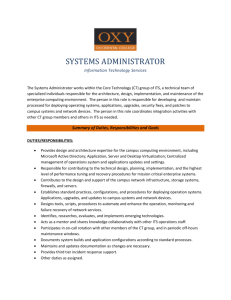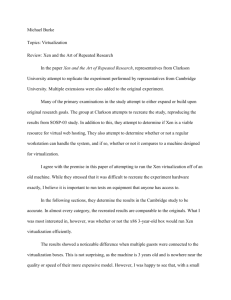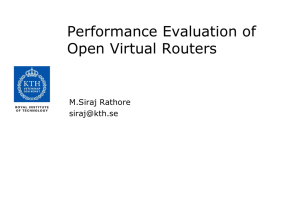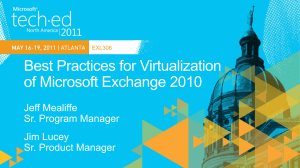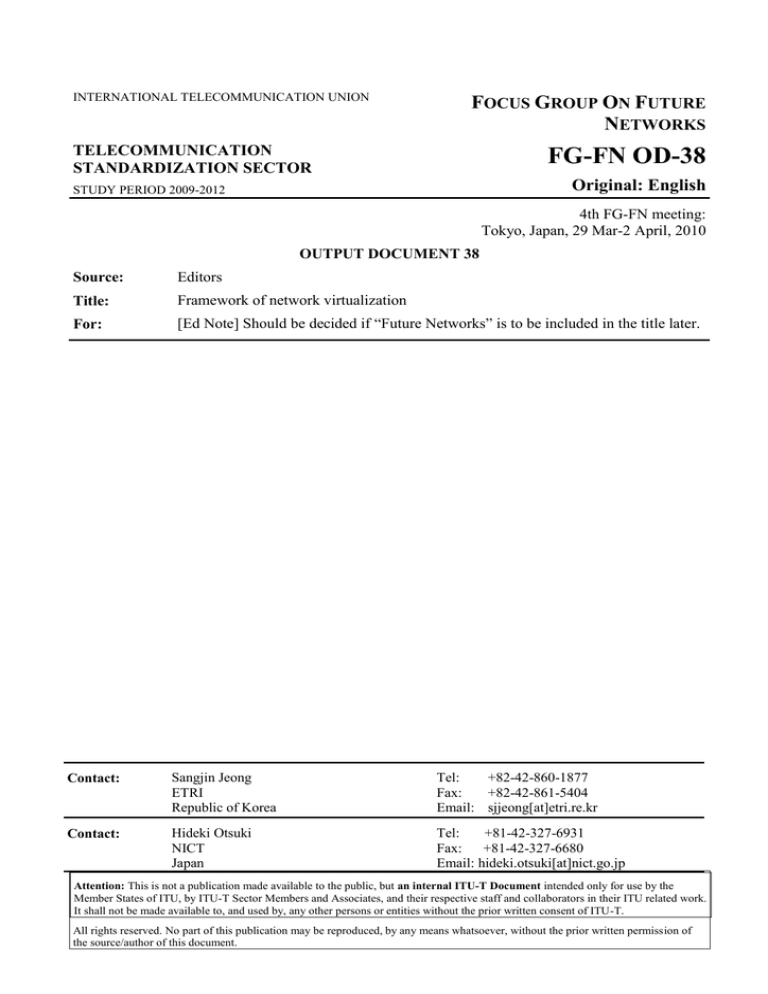
INTERNATIONAL TELECOMMUNICATION UNION
FOCUS GROUP ON FUTURE
NETWORKS
TELECOMMUNICATION
STANDARDIZATION SECTOR
FG-FN OD-38
Original: English
STUDY PERIOD 2009-2012
4th FG-FN meeting:
Tokyo, Japan, 29 Mar-2 April, 2010
OUTPUT DOCUMENT 38
Source:
Editors
Title:
Framework of network virtualization
For:
[Ed Note] Should be decided if “Future Networks” is to be included in the title later.
Contact:
Sangjin Jeong
ETRI
Republic of Korea
Tel:
+82-42-860-1877
Fax:
+82-42-861-5404
Email: sjjeong[at]etri.re.kr
Contact:
Hideki Otsuki
NICT
Japan
Tel:
+81-42-327-6931
Fax: +81-42-327-6680
Email: hideki.otsuki[at]nict.go.jp
Attention: This is not a publication made available to the public, but an internal ITU-T Document intended only for use by the
Member States of ITU, by ITU-T Sector Members and Associates, and their respective staff and collaborators in their ITU related work.
It shall not be made available to, and used by, any other persons or entities without the prior written consent of ITU-T.
All rights reserved. No part of this publication may be reproduced, by any means whatsoever, without the prior written permission of
the source/author of this document.
-2FG-FN OD-38
0. Contents
1.
Scope ............................................................................................................................ x
2.
Definition of network virtualization.......................................................................... x
3.
Introduction................................................................................................................. x
4.
Attributes of network virtualization ......................................................................... x
5.
Overview of network virtualization .......................................................................... x
5.1. LINP architecture in network virtualization framework ................................ x
6.
Applicability ................................................................................................................ x
7.
Problem spaces ............................................................................................................ x
8.
Implementation examples .......................................................................................... x
8.1. Router aspects ...................................................................................................... x
8.1.1. Functional architecture of virtualization support router......................... x
8.2. Application aspects .............................................................................................. x
8.3. Mobility aspects ................................................................................................... x
8.4. Other aspects ........................................................................................................ x
9.
Security considerations ............................................................................................. x
10.
References ................................................................................................................... x
Annex A : Use cases .............................................................................................................. x
Ed Note: It is necessary to keep consistency in using terminologies in the documents
Ed Note: It is necessary to add Terms and Definition section like other
Recommendation.
Ed Note: The overall flow of this document does not seem good. Similar to other
Recommendation, Introduction should be appeared immediately after Scope in
order to increase readability.
1. Scope
The scope of this technical document includes:
Definition of network virtualization
Introduction
Attributes of network virtualization
Overview of network virtualization
-3FG-FN OD-38
Applicability and use cases
Problem spaces
Implementation examples
Router aspects
Functional architecture of virtualization support router
Application aspects
Other aspects
[Ed Note] the relationship between network virtualization and Future Network may need to be
explicitly described in the scope.
[Ed Note] It is noted that whole procedures realizing network virtualization (provisioning, tool, etc)
needs to be described in a separate section in order to complete the framework document. Further
contributions are invited.
2. Definition of network virtualization
Network virtualization is the technology that enables the creation of logically isolated network
partitions over shared physical network infrastructures so that multiple heterogeneous virtual
networks can simultaneously coexist over the shared infrastructures. Also, network virtualization
allows the aggregation of multiple resources and makes the aggregated resources appear as a single
resource.
The virtual networks are completed isolated each other, so different virtual networks may use
different protocols and packet formats. When combined with programmability in network elements,
users of virtual networks can program the network elements on any layers from physical layer to
application layer. They can even define new layering architecture without interfering the operation
of other virtual networks. In other words, each virtual network can provide the corresponding user
group with full network services similar to those provided by a traditional non-virtualized network.
The users of virtual networks may not be limited to the users of services or applications, but may
include service providers. For example, a service provider can lease a virtual network and can
provide emerging services or technologies such as cloud computing service, and so on. The service
providers can realize the emerging services as if they own dedicated physical network
infrastructures. In order to facilitate the deployment of network virtualization, it may be necessary
to provide control procedures such as creating virtual networks, monitoring the status of virtual
network, measuring the performance, and so on.
Also, network virtualization can reduce the total cost by sharing network resources. One of
motivation of network virtualization is to achieve better utilization of infrastructures in terms of
reusing a single physical or logical resource for multiple other network instances, or to aggregate
multiples of these resources to obtain more functionality. These resources can be not only network
components, such as routers, switches, hosts, virtual machines, but also service elements, such as,
operation and measurement services, instrumental services, and so on.
Network virtualization on its own is quite a useful technology, but to gain the greatest benefit it will
be better to have a managed virtualization environment. Such management allows better control,
monitoring, and analysis of the virtualized environments.
3. Introduction
-4FG-FN OD-38
Future Network (FN) is a network which will be able to provide revolutionary services, capabilities,
and facilities that are hard to support using existing network technologies. Also, it is expected that
Future Network will overcome the limitations of the current networks. Future Network includes
core technologies that are necessary for constructing future networking infrastructure and
application service infrastructure. It is necessary that those core technologies are to be designed not
bound to the current networking technologies, because the core technologies will be developed in
order to overcome the limitations of the current networks. It is required to construct testbeds so as
to design, develop, and evaluate the revolutionary core technologies. Especially, developing the
core technologies may require complete new network environment from the current network
architecture and the operation of one technology should not make unexpected effects to others. It is
also considered one of the main promising technologies for construction of Future Networks, as
reflected in the extensive current research carried out globally. Therefore, the testbeds should
provide isolated network environment to the developers, providers, and users of the core
technologies. Network virtualization is the prominent technology that can realize the isolation of
networks and can be used to build the large scale testing infrastructure for Future Network
technologies.
-5FG-FN OD-38
4. Attributes of network virtualization
This section describes the attributes of network virtualization.
4.1. Programmability
4.2. Topology awareness
4.3. Quick reconfigurability
Today’s network application traffic tends to indicate more and more unpredictable variations.
Hence, each virtual network would like to adjust available bandwidth according to traffic demand
changes. Thus, the network virtualization should offer a method that the virtual networks are
capable of easily and rapidly creating their own network topologies and dynamically reconfiguring
them.
4.4. Isolation
Virtual networks can be multiplexed over a common packet based network infrastructure. However,
this can be liable to restrict network performance and cause instability due to interference by other
virtual networks. The network virtualization should be capable of providing the complete
performance isolation among virtual networks.
4.5. Network abstraction
4.6. Performance
It is known that some of emerging network services will require extremely high bandwidth of more
than 10 Gbps with low latency and jitter. However, current packet-based technologies cannot satisfy
such requirements. Each virtual network (or customer) should be capable of directly utilizing lowerlayer transmission technologies such as wavelength and TDM (time-division multiplexing)
provided by a transport network.
4.7. Security
To support diversified network services, the virtual network should retain the capability of
customizing network control and operations independent from those in the physical network or
other virtual networks. At the same time, the virtual network wishes to avoid complex physical
network operations that are fully dependent on the types of network layers and equipment vendors.
To disengage the virtual network from the complexity of the physical network, the network
virtualization should conceal a part of the physical network information and provides the simple
interface for resource control to the virtual networks.
4.8. Management
Considering the utility of customers, each virtual network should be capable of using physical
network resources and constructs a network topology. However, one possible problem is that some
malicious virtual network may occupy most of the resources, which deteriorates other virtual
network performance due to network resource exhaustions. So, the network provider should have
the capability of regulating the upper limit of bandwidth usage by each virtual network to maintain
the overall utility and performance.
[Ed Note] this section should be divided into two sections. One is Manageability that describes
-6FG-FN OD-38
network operator’s viewpoint, and Programmability that provides user’s point of view.
[Ed Note] Further contributions regarding to Programmability is invited.
[Ed Note] In-system management approach is required in management section.
4.9 Mobility
When the user's demands is changed or network performance falls below Quality of Service
thresholds, the network elements (e.g., resources (storages, computing powers, network interfaces,
etc.) , system images, applications) can be moved to satisfy the user's demands and provide stable
network performance. Therefore, network virtualization should support not only mobility of one
physical network to another but also mobility of the network elements including users among
logical network partitions. The network elements are composed of resources, system images and
applications, which are added for the improvement of network performance or removed for load
balancing or energy saving purpose. Users can be dynamically attached or reattached to one of the
virtualized networks depending on the desired application without any interruption of
communication.
Note: this kind of mobility is sometimes called migration.
-7FG-FN OD-38
5. Overview of network virtualization
5.1 LINP architecture in network virtualization framework
Network virtualization is required to be capable of providing multiple LINP (Logically Isolated
Network Partition) those are isolated each other. LINP may be created over the single physical
infrastructure.
Figure 5-1 represents the architecture of LINP which creates multiple virtualized infrastructures in
network virtualization framework. Each LINP is isolated each other and is programmable to satisfy
the user’s demand on the functionality and amount. User’s demand is conveyed to slicing manager
which is required to coordinate infrastructures so that appropriate LINP is provided to the user.
LINP manager is recommended to handle user’s demand with real-time or scheduled.
LINP manager
On-demand,
Scheduled
LINP 1
Users
LINP 2
LINP 3
LINP manager
Resource slicing
per user’s
demand
Figure 5-1: LINP architecture in network virtualization framework
6. Applicability
This section describes the applicability of network virtualization.
The applicability of network virtualization may be classified into two broad categories according to
the characteristics of virtualization; namely isolation and aggregation.
From the view point of isolation, network virtualization enables the complete isolation between
each logical network partition. Typical use case of this category is that it is possible to create new
business model by separating the conventional Internet service provider’s role into network
provider and service provider. The network provider creates customized logical network partitions
according to the service providers’ requirements, such as network bandwidth, the number and
functional capability of network elements in the logical network partitions, total cost, and so on.
The service provider can provide various services and applications for users without the burden of
building its own network infrastructure. Moreover, the service provider can safely test an innovative
pilot service or application that requires special features of network without affecting other existing
-8FG-FN OD-38
services. From the perspective of network providers, they can increase the hardware utilization ratio
and can reduce the operational cost of network infrastructure. From the viewpoint of service
providers, it is possible to reduce the cost for building network infrastructure. Also, they can utilize
the flexibility for the creation of network and application services.
The second applicability is aggregation. In the computing field, it is common to logically aggregate
multiple computing resources into a single resource in order to support applications or services that
require very high performance exceeding single resource’s capability. Building a high performance
computing node by clustering many smaller nodes would be the typical use case of resource
aggregation. Similar to this use case, network virtualization can allow building a logical network
element whose capability is hard to be supported by a single one. The logical network element can
support various functions and can easily expand its capability by aggregating multiple network
elements.
[Ed Note] Add Pros and Cons of network virtualization (invite future contribution)
[Ed Note] How to orchestrate different capability or functions of network virtualization should be
investigated in applicability section.
7. Problem spaces
This section describes the problem spaces of network virtualization.
7.1 Isolation
Legacy networks, such as the Internet, enable users to exploit multiple network services over a
shared physical infrastructure, so a service may be affected by other coexisting network services.
As a consequence, this can cause security problems. Network virtualization guarantees
independence of network services by creating independent logical traffic paths to isolate traffic
between users belonging to separate groups.
[Ed Note] this mention only on isolation of traffic, and that is the same with traditional VPNs or
other virtualization technologies. The new things in network virtualization are performance and
resources. We invite further contributions on these points.
7.2 Performance
In legacy networks, the network service providers hardly offer resources encompassing the physical
capability of the resources. However, by leveraging network virtualization, it is possible to provide
high performance resources for users by logically aggregating multiple resources into single
resource. Therefore, a logical network consisting of requested resources can guarantee users’
performance requirements.
7.3 Scalability
It is actually restricted to scale physical resources according to users’ demands in legacy networks.
Users of network virtualization, however, can add as many virtual resources to their virtual network
as they need. That is, requested size of a virtual network can be provided. In addition to the size,
coexistence of multiple logical networks is one of the fundamental motivations behind network
virtualization. Legacy networks hardly provide multiple networks, but multiple virtual networks can
be created in a shared physical network with the same resources.
[EdNote] the capability of accepting different network architecture depends on the architecture,
implementation, etc. of network virtualization technologies, and each technology has its pros and
cons (e.g., technology with specialized, limited capabilities usually have better performance).
-9FG-FN OD-38
Investigation on such pros and cons should be discussed in this document, not necessary in this
section. Further contributions are invited.
[EdNote] The investigation on pros and cons of network virtualization will be added in
Applicability section based on further contributions.
7.4 Flexibility
In legacy networks, network providers have only to offer limited physical resources, and users only
exploit restricted resources, e.g., nodes connected by physical links in a local area. However, in
network virtualization, not only local resources but also remote resources can be provided and
belong to a virtual network. Then users can use arbitrary network topology, forwarding or routing
functions, and customized control protocols.
7.5 Evolvability
If network providers want to deploy a new network technology, such as new network layer
protocols in the current network architecture, they need to construct a separate testbed so that the
behavior of the new protocols does not affect the current services. After evaluating the new
technology, the network provider deploys the technology to their network. However, this approach
may lose legacy support or backward compatibility and users may be reluctant to adapt the new
feature because the new technology may not support their existing services. By utilizing network
virtualization, the network providers can integrate legacy support by allocating the existing
networks to a logically isolated network partition. This partition will guarantee that the existing
services and technologies may not be changed [9].
7.6 Management
Since each virtual network is independent from other virtual networks, it has to be managed
independently from other virtual networks. At the same time, the management system for the virtual
network has to collaborate with the management system of physical infrastructure. It is therefore
necessary to carefully define which part of management can be done by the management system of
the virtual network, and how to align it with that of physical infrastructure. Moreover, if the
isolation is not perfect, alignment with the management systems of other virtual networks also
becomes necessary.
Ed Note: More refined text will be provided by Takashi Egawa
Ed Note: Revise the text according to describe challenging tasks such as hierarchical management,
isolation (or independent) management systems
7.7 Security
In the legacy network, failure or malfunction in one service or network can be spread over the
whole network. Also, if a network element is compromised by a malicious user, the whole traffic
traversing the element may be a target for attack. Since network virtualization ensures complete
isolation among logical network partitions, the security problems do not be spread over the whole
network partitions [9].
- 10 FG-FN OD-38
8. Implementation examples
This section describes the implementation examples of network virtualization.
8.1. Router aspects
8.1.1. Functional architecture of virtualization support router
In general, the router architecture to support virtualization capability requires three layers, router
hardware, router software, and control framework, respectively. Figure 8-1 shows the functional
architecture of virtualization support router.
The router hardware typically consists of switching component for packet forwarding and flow
table. The router software performs router’s main operations such as running routing protocols and
building routing table, and so on. The router software may include virtualization layer in order to
support virtualization in router. The virtualization layer typically creates and manages logically
isolated virtual systems, which can run various components on the native hardware. Thus, the
virtualization layer can support virtualization of router hardware resources by creating the isolated
virtual systems, i.e. virtual router. The virtual router is a software implementation of a router that
executes the same operations as a physical router. It is an isolated partition of a real router. Multiple
virtual routers can coexist over the virtualization layer and each virtual routers are completely
isolated each other so that one virtual router does not affect others. In order to provide the
management of virtual routers, the virtualization layer can include the virtual machine monitor or
hypervisor function. The control framework performs the interaction between the virtual or physical
router and other network entities. Control framework defines interfaces, message types including
basic protocols and required functions, message flows between router and network entities. The
network entities may include networking elements such as routers, switches, and so on. It also may
include logical entities such as registry for managing of LINPs, network resources, and user
information. Each LINP and virtual routers are managed by resource manager that are implemented
in the control framework of the physical router. The resource manager is in charge of creating and
managing LINPs and virtual routers in the physical router.
Control Framework
Router Software
Virtual Router (VR) Virtual Router (VR)
VR Software
VR Hardware
VR Software
VR Hardware
…
Virtualization Layer
Router
Hardware
Switching
Component
Flow Table
Figure 8-1: Functional architecture of virtualization support router
[Ed Note] Mapping between LINP and virtual router should be provided. Further contribution
necessary.
- 11 FG-FN OD-38
8.1.2. Control framework architecture
This section describes the architecture of control framework including the design of functional
entities and interfaces between the entities.
[TBD]
8.1.3. Router software architecture
This section presents references or software implementation profiles in order to support
virtualization in the router. It also defines interfaces between router software and control
framework.
[TBD]
8.1.4. Router hardware architecture
This section provides considerations of hardware architecture in order to support virtualization in
the router.
[TBD]
8.2. Application aspects
Figure 8-2 shows an example of relation between applications and LINPs. Each application
accesses the LINP to control the functionality of the LINP, such as routing. Multiple applications
may access the same LINP.
[Ed. Note] Terms and definitions of “physical network infrastructure”, “LINP”, and “virtualized
network management” should be aligned with the previous sections.
App1
App2
App3
App4
App5
App6
Application
LINP1
LINP2
Virtualized
Network
LINP3
Physical Network Infrastructure
Figure 8-2: Relationship between application and LINP
Figure 8-3 shows another example of relation between applications and LINPs. Here, application
platform is introduced. The task of Application platform is to receive requests from the application
and (1) access LINP to control the functionality of the LINP, (2) access virtualized network
management to reconfigure LINP.
[Ed. Note] An explanation of large and small arrows in the figure should be added.
- 12 FG-FN OD-38
[Ed. Note] An explanation of why the application platform needs to reconfigure LINP (ex. to
optimize resource usage) should be added.
App1
App2
App3
App4
App5
App6
Application
App Platform
App Pf
App Platform
reconfigure LINP
Virtualized Network Management
Access LINP
Virtualized
Network
LINP1
LINP2
LINP3
Physical Network Infrastructure
Figure 8-3: Relationship between application and LINP
8.3 Mobility aspects
Figure 8-4 illustrates the relationship between LINPs and network elements. Each application can
be moved from one LINP to another. In addition, a number of resources and system images can be
added and removed according to the user's demand or requirement of the network performance.
Therefore, the manager of LINPs should handle their mobility in real-time or in the scheduled time.
APP1
APP2
APP3
move
Resources
Resources
move
LINP 1
ADD
REMOVE
LINP 2
System Images
move
User1
User2User3
LINP 3
move
User3
Figure8-4: Relationship between LINPs and network elements
8.4. Other aspects
System Images
- 13 FG-FN OD-38
9. Security considerations
[TBD]
10. References
[1] GENI Design Principles, GDD-06-08, August 11, 2006.
[2] Susanna Avéssta, FIREworks D2.7 Draft Cooperation Concept, 2009.
[3] The GENI Project Office, “GENI (Global Environment for Network Innovations) System
Requirements Document,” July 7, 2009.
[4] http://www.geni.net/
[5] “Design for Future Internet Service Infrastructures”, p. 227, Towards the Future Internet G.
Tselentis et al. (Eds.) IOS Press, 2009
[6] “Proposal for a new project description on virtualization of multilayer transport network”
FGFN C-xx, the third FGFN meeting
[7] S. Jeong, et al., “Draft Deliverable - Framework of Network Virtualization,” in the Proc. of
ITU-T FG-FN, Salt Lake City Meeting, 2009.
[8] N.M. Mosharaf, et al., “A Survey of Network Virtualization,” Technical Report: CS-2008-25,
October 15, 2008.
[9] N.M. Mosharaf, et al., “A Survey of Network Virtualization,” Technical Report: CS-2008-25,
October 15, 2008.
- 14 FG-FN OD-38
Annex A : Use cases
[Ed Note] use-cases should be described carefully; only indispensable use-cases should be written
in the main body, and it should be short not to harm readability of normative part. With that, editors
will massage the text here to fit into applicability section.
[Ed Note] in general use cases here are very specific. Generalizing it could be a good exercise to
think applicability of these use cases, and the applicability of network virtualization technology.
[Ed Note] Further contributions about generalized use cases are invited.
[Ed Note] many people believe virtualized network is a part of the cloud computing, or computing
technologies. We must be very careful of this perception, and a use case that clears this point is
highly necessary.
[Ed Note] Further contribution investigating the use cases relationship between network
virtualization and cloud computing is invited.
In this annex, the systematic knowledge of the use cases of network virtualization is described in
order to clarify the purpose of network virtualization technology. The systematic description can be
used as a guideline for describing the use cases, so further contributions regarding use cases should
follow this guideline.
[Ed Note] the floor agreed that this is a good guideline to submit use cases. In the use-case
appendices it should be mentioned that future contribution of use cases should follow this guideline.
In A.1, the list of use cases of network virtualization and the current status of network virtualization
technology for each use case, and the categorization of use cases in A.2 are described.
A.1. List of use cases of network virtualization and current degree of maturation
A.1.1. Case1: the use case for feasibility experimentation of the new network architecture [1]
A.1.1.1 Use case
Who
- National research institutes
To whom
- Researchers interested in the new network architecture
Why
- The feasibility experimentation over at-scale experimental network is required to globally
develop innovative new network architecture. Multiple experimentations are explored in one
experimental network at the same time.
What
- Researcher wants the virtual network to consist of a virtual node and virtual links. The virtual
node is required to work with the customized routing protocols.
When
- This service is needed now.
A.1.1.2 Current status of technology
There are on-going project developing open standard such as OpenFlow [x] that allows running of
experimental protocols in programmable flow switches.
- 15 FG-FN OD-38
[Ed Note] Whether to include particular project name in FG-FN document or not is to be discussed
FG-FN management level
Control frameworks for resource contention management are under development.
A.1.2 Case 2: network virtualization for application service provider
A.1.2.1 Use case
Who
- Application service provider who owns the computer systems and local area network
infrastructures. The application service provider enables their customers to use the computer
systems.
[Ed Note] the terms and concepts used in these use cases, e.g., application service provider, needs to
be clarified.
[Ed Note] Further contribution is invited in order to clarify the meaning of application service
provider.
To whom
- Application service providers
Why
- Recently, application service providers deploy computer systems in multiple locations to
improve their service availability. When the systems in location (A) are out of order, all
applications running on these systems are run on the systems in another site (B) instead. In this
case, it is desirable that the application-user is not aware of this change. Thus, the systems
deployed in different locations should be handled in the same manner as those located in the
same location.
What
- One virtual computer system consists of multiple computer systems deployed in different
locations, and one virtual network output link consists of multiple network output links deployed
in different locations. The virtual computer system and virtual network output links should be
synchronized.
When
- Application service provider requires these services now.
A.1.2.2 Current status of technology
A.1.3 Case 3: network virtualization for the network service provider who owns the network
infrastructures
A.1.3.1 Use case
Today there are network service providers who own several different networks and provide several
different services on each network. Networks should be operated using its management policy
according to each service quality. For example, PSTN, dedicated line service, internet service, and
mobile network service.
Several service networks must be composed from common physical network infrastructure.
- 16 FG-FN OD-38
Ex. multilayer network architecture [3]
A.1.3.2 Current status of technology
Logical router technology is implemented in commercial products. With this technology, multiple
virtual routers can be created on one router, and IP routing protocol can be performed on virtual
routers independently.
With programmable flow switching technology, the forwarding table of switch nodes can be
controlled by the external servers.
The management framework for virtual networks, which consist of multiple-layer resources (ex.
WDM-circuit and packet-switching networks) are under development. The virtual networks must be
completely isolated from each other and the physical resource be optimally used.
A.1.4. Use cases of mobility in virtualized network
A.1.4.1 User/Application Mobility
Figure A-1 shows use cases of user and application mobility in virtualized network.
APP1
APP1
LINP Manager
LINP 1
User1
move
APP2
APP1
LINP 2
LINP 1
User1
User1
(a) User Mobility
move
APP1
APP2
LINP 2
move
User1
(B) Application Mobility
Figure A-1. Uses cases of user and application mobility
Each virtualized network may provide different network resources. In this example, LINP 1 is
created based on small network resources such as low power CPU, limited Memory, and low
bandwidth. On the contrary, LINP 2 is created based on extra large network resources in order to
process large amount of data, and support applications which require high computing power. In this
case, User 1 is currently connected with LINP 1 to use APP1. When User 1 needs to use APP 2
which requires high computing power, the LINP manager discovers LINP 2 for User 1. In addition,
if User 1 still needs to use APP1, APP1 can be accessed from LINP 2 or APP1 can be moved from
LINP 1 to LINP 2 for User 1. Therefore, the LINP manager will handle not only the user mobility
but also the mobility of application which is used by the user in the previous LINP.
A.1.4.2 Resource/System Image Mobility
Figure A-2 shows use cases of system image and resource mobility.
- 17 FG-FN OD-38
APP1
APP1
APP1
System Images
System Images
Add
Remove
Resources
Add
LINP Manager
Remove
move
LINP 1
Resources
LINP 1
LINP 2
(a) System Image Mobility
LINP 2
(B) Virtual Resource Mobility
Figure A-2. Uses cases of system image and resource mobility
In this example, the system images can be moved from LINP 1 to LINP 2 according to user's
demand, application type, and other reasons without any interruption. Furthermore, both system
images and resources can be added to LINP 1, and removed from LINP 2 in order to achieve high
network performance and energy saving. Therefore, the LINP manager should handle the mobility
of system images and resources between LINPs.
A.1.5. Case 5: other possible cases
There are other possible use cases, and they will be added to this document.
A.2 Use case categories and their applicability
T.B.D.
____________

